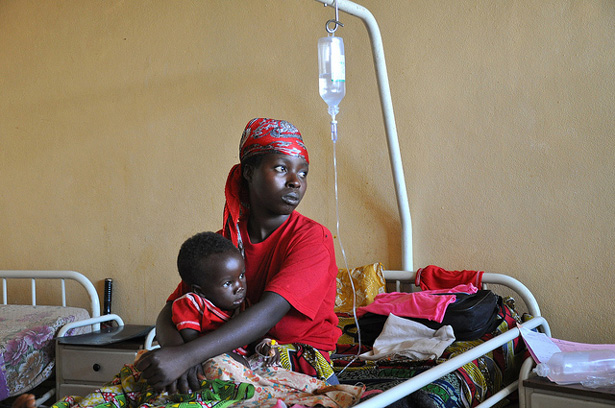-
Malaria and Maternal Health: Treating Pregnant Women Reveals Need for Integration
February 5, 2013 By Lauren Herzer Risi
Ten years ago, a study was conducted in Mozambique to determine the impact of a new medicine for pregnant women with malaria. Over 1,000 women participated in a controlled trial of intermittent preventative treatment with sulphadoxine-pyrimethamine – half received a placebo, the other half received the actual drug. All were given an insecticide-treated net.
The study found that for those women that received the medicine, there was a 61.3 percent reduction in neonatal mortality; 51 percent reduction in fetal anemia; and 40 percent reduction in the incidences of clinical malaria episodes. The treatment was also found to be highly cost effective, especially after the savings from reduced anemia, oftentimes a result of malaria during pregnancy, were factored in.
The infants born to the women who did not receive the treatment experienced a significantly higher death rate.
A Compound Global Health Challenge
The presentation of this study, in the midst of countless technical presentations at the recent Global Maternal Health Conference in Arusha, prompted a rare emotional response from the audience. One woman asked, “How do you address the ethical implications of the difference in mortality experienced by the placebo group, which experienced a 60 percent increase in mortality?”
The presenter and researcher, Clara Menéndez, responded thoughtfully. “Ethical issues are critically important in any research,” she said. But at the time of the study, there was little or no information on the additional effectiveness of intermittent treatment over treated nets to protecting women from malaria during pregnancy.
Malaria in pregnancy is a massive and compound global health problem. The World Health Organization (WHO) estimates that each year, 50 million women become pregnant in malaria-endemic countries around the world and “an estimated 10,000 women and 200,000 of their infants die as a result of malaria infection during pregnancy.” Anemia – a lack of healthy red blood cells that can lead to death – is the biggest risk but low birth rate, neonatal death or stillbirth, and spontaneous abortion are also more likely.
The WHO now recommends a combination of intermittent preventive treatment with sulphadoxine-pyrimethamine and insecticide-treated nets as an effective means to preventing and treating malaria in pregnancy.
But, Menéndez said, the study was done in 2003:
Most countries in Africa weren’t implementing the [World Health Organization’s recommended] policies. …Of course the study went through all of the ethical reviews both within and out of the country, with the Minsters of Health. The neonatal mortality in the placebo group wasn’t higher than the community, just compared to the intervention group.
In 2006, after the results the trial, Mozambique did implement the WHO’s policy of intermittent preventative treatment alongside treated nets.
Many and Varied Barriers to Care
Despite these breakthroughs – and the hard choices made to achieve them – there are still many barriers to the delivery, access, and use of intermittent preventative treatment for both healthcare providers and the millions of pregnant women with malaria today.
A recent study conducted by the Malaria in Pregnancy Consortium attempted to do a systematic review of these barriers in sub-Saharan Africa. They found that many pregnant women lacked knowledge of the benefits of intermittent preventative treatment and insecticide-treated nets; had unwarranted fears regarding perceived side effects; and/or did not attend routine antenatal care visits to healthcare providers, which are required for the treatment to be administered. Healthcare providers, on the other hand, were sometimes confused about the timing and dosing of treatments; lacked basic supplies, such as water cups; and/or were sometimes out of stock of the treatment.
Understanding this context – one where education is rare, misconceptions common, agency low, and supplies scarce – is key to removing barriers to care. Recognizing this, the WHO has suggested improving integration between reproductive health and malaria programs to concentrate resources and try to create single access points for women’s health.
In a presentation on the panel in Arusha, Viviana Mangiaterra of the WHO and Roll Back Malaria, highlighted the importance of this point. “Harmonization of national policies, guidelines and training materials between [reproductive health] and malaria control, as well as strong commitment to national level coordination, can ensure effective implementation of malaria in pregnancy programming,” she said. “This can lead to one point of care which ultimately simplifies care for the patient, minimizes dropout, supports the continuity of care, promotes a comprehensive approach to women’s health, and leads to improved outcomes.”
While significant gains in malaria control have been made in the last decade, global funding for malaria prevention and control has leveled off in recent years, sparking a concern that some of the gains made could be lost. According to Mangiaterra, most countries have not achieved country or global targets for intermittent preventative treatment, insecticide-treated nets, or effective case management – the three-pronged approach recommended by the WHO.
Indeed, included in the WHO’s latest recommendations is a specific urging to national health authorities in Africa to correct misconceptions and confusion about intermittent preventive treatment in order to reverse slowing efforts to make the treatment more widely available.
Knowing what treatments work is a crucial step forward in preventing and treating malaria in pregnancy. But local cultural and social contexts need to be accounted for too. Integrating reproductive health and malaria programs will strengthen the ability of healthcare providers to reach this vulnerable population.
The Wilson Center’s Sandeep Bathala and Lauren Herzer blogged from the 2013 Global Maternal Health Conference in Arusha, Tanzania, from January 15 to 17, 2013.
Sources: Malaria in Pregnancy Consortium, PLoS One Medicine, World Health Organization.
Photo Credit: Woman and child recover from malaria in Burundi, courtesy of Maria Cierna/United Nations Development Program.
Topics: Africa, development, Dot-Mom, From GMHC 2013, gender, global health, maternal health, Mozambique, Stillbirth
 A Publication of the Stimson Center.
A Publication of the Stimson Center.






